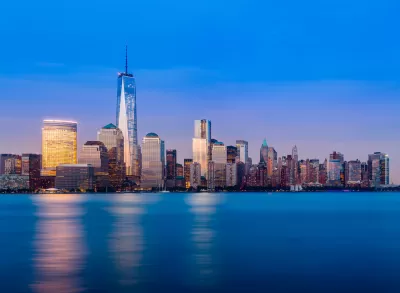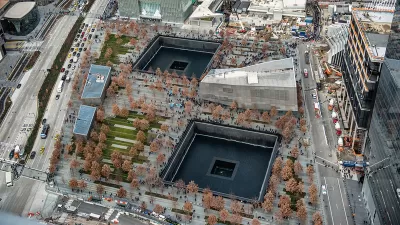Despite predictions that the events of September 11, 2001 would be the end of skyscrapers, U.S. cities are building more tall buildings than ever.

In the days following 9/11, "[a] Chicago developer told Chicago Tribune architecture critic Blair Kamin that American cities shouldn’t allow new skyscrapers that could 'be viewed as a magnet for future terrorism,'" and Americans wondered whether they would ever feel safe in tall towers again. Yet since 2001, "a dozen towers have gone up in Chicago that top 700 feet," writes John King, and other cities are seeing similar rates of construction.
According to Carol Willis, director and curator of the Skyscraper Museum in New York, "there are strong forces that cause towers to grow when there are good economic conditions. They’re weeds." As the rebuilt towers went up in place of the fallen World Trade Center, "[p]eople were reminded that tall buildings can express the spirit and potential of large cities." Today, the area surrounding Ground Zero "is ringed with towers that include the 1,776-foot One World Trade Center, the nation’s tallest building."
"In terms of a city’s daily life, the best towers are the ones that give something to the public. They’re approachable, with shops and cafes and nooks that are open to people who never enter the high-rise lobby." In San Francisco, says King, "when you walk along Folsom Street, or cut through landscaped mid-block plazas that didn’t exist before, the skyline show is secondary to the pedestrian environment slowly starting to emerge." According to Brian Lee, a consulting partner at Skidmore Owings & Merrill in Chicago, "[b]uildings should be meaningful for your time. If it’s just arbitrary shaping, that’s super-disappointing."
FULL STORY: 9/11 was supposed to end the age of skyscrapers. Instead, there are more now than ever

Montreal Mall to Become 6,000 Housing Units
Place Versailles will be transformed into a mixed-use complex over the next 25 years.

Planetizen Federal Action Tracker
A weekly monitor of how Trump’s orders and actions are impacting planners and planning in America.

California High-Speed Rail's Plan to Right Itself
The railroad's new CEO thinks he can get the project back on track. The stars will need to align this summer.

Tenant Advocates: Rent Gouging Rampant After LA Wildfires
The Rent Brigade says it's found evidence of thousands of likely instances of rent gouging. In some cases, the landlords accused of exploiting the fires had made campaign donations to those responsible for enforcement.

Seattle’s Upzoning Plan is Ambitious, Light on Details
The city passed a ‘bare-bones’ framework to comply with state housing laws that paves the way for more middle housing, but the debate over how and where to build is just getting started.

DOJ Seeks to End USDOT Affirmative Action Program
The Disadvantaged Business Enterprise Program encouraged contracting with minority- and women-owned businesses in the transportation sector, where these groups are vastly underrepresented.
Urban Design for Planners 1: Software Tools
This six-course series explores essential urban design concepts using open source software and equips planners with the tools they need to participate fully in the urban design process.
Planning for Universal Design
Learn the tools for implementing Universal Design in planning regulations.
City of Camden Redevelopment Agency
City of Astoria
Transportation Research & Education Center (TREC) at Portland State University
City of Camden Redevelopment Agency
Municipality of Princeton (NJ)
Regional Transportation Commission of Southern Nevada




























